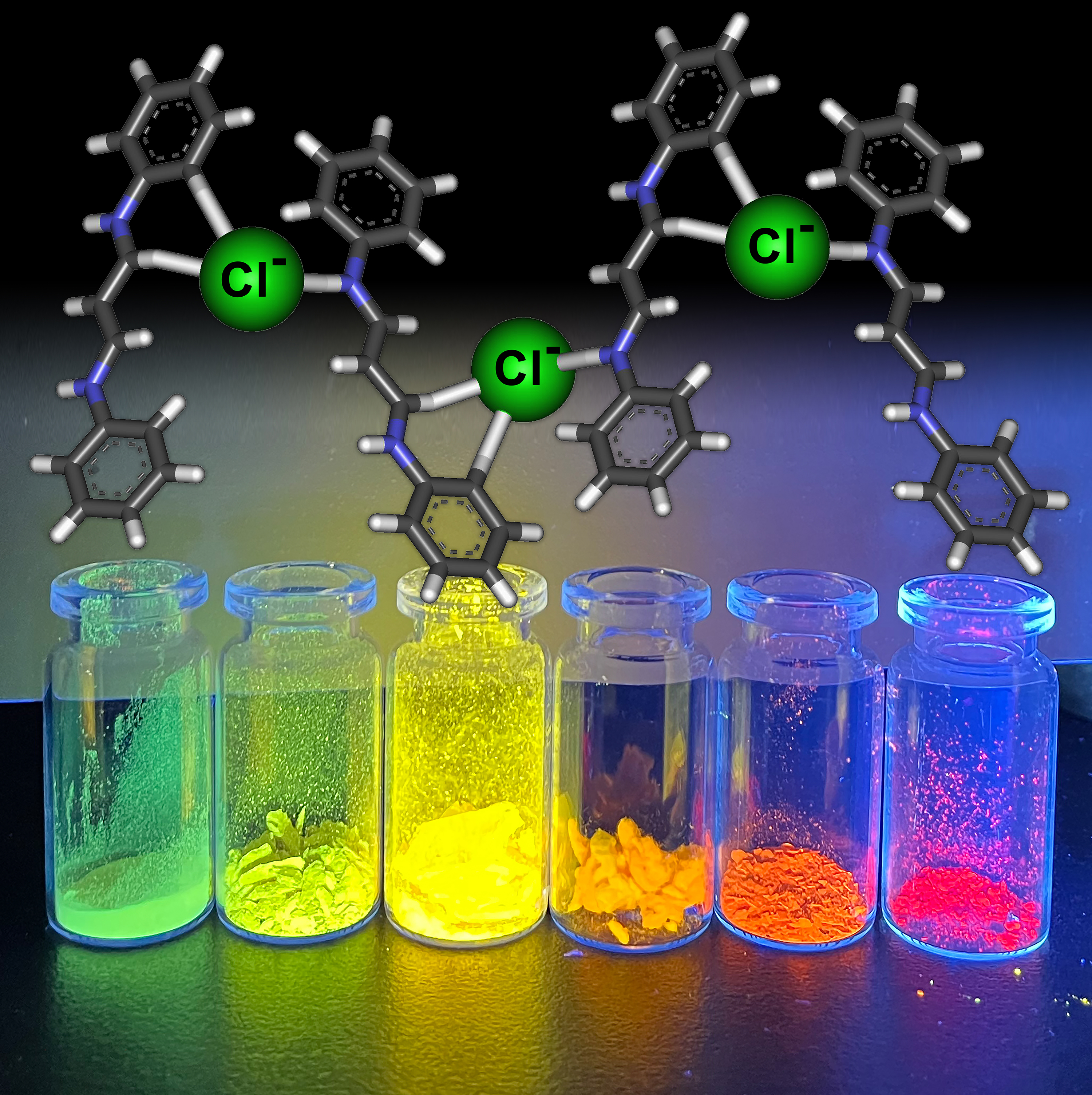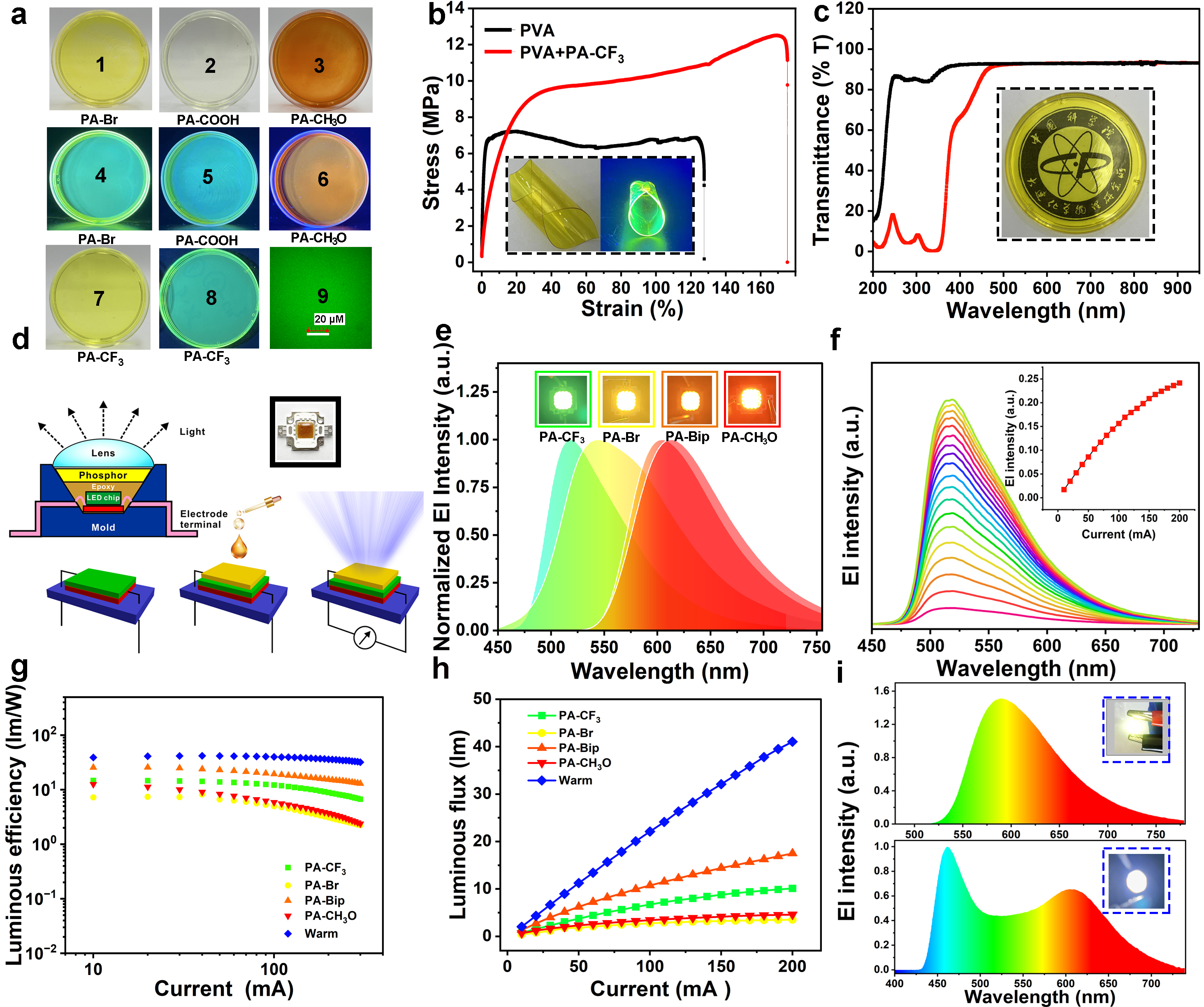近日,我组发现一种卤素键驱动的聚集诱导发光分子骨架:N-(3-(苯基氨基)烯丙基)苯胺盐酸盐。该骨架显示出强的固态发光效率,绝对量子产率最高达到81.9%,以及超大的斯托克斯位移(276 纳米)和典型的AIE特征。
聚集诱导发光(AIE)是一种独特的发光现象,最早由唐本忠院士在2001年首次提出,该发光行为是克服聚集诱导淬灭效应的一个关键现象。近20年来,基于AIE的研究如雨后春笋般涌现,特别是经典的分子骨架六苯基硅(HPS),四苯基噻吩(TPE)和三苯胺(TPA)被发现后,一系列创新性研究成果被开发出来,研究邻域涵盖了生物成像、光电子器件(如OLED)、圆偏振发光(CPL)、发光治疗学等。然而,一个突出的问题是,当前AIE分子骨架的种类和数量非常有限,这对科学家对基于AIE的广泛研究是不利的,对发光材料的深入研究产生一定限制。因此,开发新的AIE骨架具有重要意义,不仅能够探索新的机制,提出新的概念,还能创造新的应用。同时,经典的AIE分子合成路线复杂、溶解度差、难以纯化、产率低,这限制了其进一步的结构优化和改造。此外,这些分子大多发射在短波长区域,通常发射蓝光或绿光。然而,具有长波长的AIE分子具有更深的组织穿透能力和免受背景干扰的能力在实际应用中更有价值。因此,发展可调节波长、高量子产率和易于制备的新型AIE骨架对发光邻域是革命性的,这将促进发光领域许多令人兴奋的应用,如光电探测器、白光发光二极管(WLED)、太阳能电池和场效应晶体管。

基于此,本课题组发现了一种全新的AIE分子骨架PA,该骨架是在室温下利用四甲氧基丙烷和苯胺在乙醇中一锅反应合成的,具有较高的收率。基于这一优势,该骨架可以轻松地通过引入不同的取代基进行修饰,产生了20多个基于PA的衍生物。所有这些化合物都符合典型的AIE特征,这说明了PA骨架的良好可扩展性。通过调节苯基上的给电子基团或吸电子基团,可以方便地改变这些AIE分子的发射波长和荧光量子产量,有助于形成一个全波段发光AIE系统。此外,该分子骨架在卤键相互作用的驱动下,展现出色的自组装能力和结晶能力,一系列有趣的自组装结构被观察到并且通过单晶结构进行了验证。基于该分子骨架的强烈固态发光能力,发展了一系列性能优异的发光薄膜和OLED器件,为发光材料的应用增添了新的元素。

相关研究成果以“Halogen Bond-Driven Aggregation-Induced Emission Skeleton: N-(3-(Phenylamino)allylidene) Aniline Hydrochloride”为题,于近日发表在美国化学会期刊ACS Appl. Mater. Interfaces上。该工作的第一作者是18T7组博士研究生常永新。上述工作得到国家自然科学基金、我所创新基金、兴辽英才计划等项目的支持。(文/图 常永新)
文章链接:https://doi.org/10.1021/acsami.2c21073
Halogen Bond-Driven Aggregation-Induced Emission Skeleton:N‑(3-(Phenylamino)allylidene) Aniline Hydrochloride
Yongxin Chang, Haijuan Qin, Fusheng Zhang, Zhiying Yang, Yahui Zhang, Dongdong Wang, Ce Bi, Miao Guo, Wenjing Sun, and Guangyan Qing*
ACS Appl. Mater. Interfaces, 2023, 15, 9751-9763
DOI: 10.1021/acsami.2c21073.
Aggregation-induced emission (AIE) is a unique photophysical process, and its emergence brings a revolutionary change in luminescence. However, AIE-based research has been limited to a few classical molecular skeletons, which is unfavorable for in-depth studies of the photophysical characteristics of AIE and the full exploitation of their potential values. There is an urgent need to develop new skeletons to rise to the challenges of an insufficient number of AIE core structures and difficult modification. Here, we report a novel dumbbell AIE skeleton, in which two phenyls are connected through (E)-3-iminoprop-1-en-1-amine. This skeleton shows extremely strong solid-state emission with an absolute quantum yield up to 69.5%, a large Stokes shift, and typical AIE characteristics, which well resolves the challenge of difficult modification and low luminous efficiency of the traditional AIE skeletons. One-step reaction, high yield, and diversified modification endow the skeleton with great scalability from simple to complicated, or from symmetrical to asymmetrical structures, which establishes the applicability of the skeleton in various scenarios. These molecules self-assemble into highly ordered layer-, rod-, petal-, hollow pipe-, or helix-like nanostructures, which contribute to strong AIE emission. Crystallographic data reveal the highly ordered layer structures of the aggregates with different substituents, and a novel halogen bond-driven self-assembly mechanism that restricts intramolecular motion is clearly discovered. Taking advantage of these merits, a full-band emission system from green to red is successfully established, which displays great potential in the construction of light-emitting films and advanced light-emitting diodes. The discovery of this AIE skeleton may motivate a huge potential application value in luminescent materials and lead to hitherto impossible technological innovations.